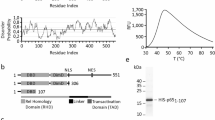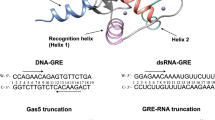Abstract
TRANSCRIPTION factors of the NFAT family regulate the production of effector proteins that coordinate the immune response1. The immunosuppressive drugs FK506 and cyclosporin A (CsA) act by blocking a Ca2+-mediated signalling pathway leading to NFAT. Although FK506 and CsA have enabled human organs to be transplanted routinely, the toxic side-effects of these drugs limit their usage. This toxicity might be absent in antagonists that target NFAT directly. As a first step in the structure-based search for NFAT antagonists, we now report the identification and solution structure of a 20K domain of NFATc (NFATc-DBD) that is both necessary and sufficient to bind DNA and activate transcription cooperatively. Although the overall fold of the NFATc DNA-binding domain is related to that of NF-κB p50 (refs 2, 3), the two proteins use significantly different strategies for DNA recognition. On the basis of these results, we present a model for the cooperative complex formed between NFAT and the mitogenic transcription factor AP-1 on the interleukin-2 enhancer.
This is a preview of subscription content, access via your institution
Access options
Subscribe to this journal
Receive 51 print issues and online access
$199.00 per year
only $3.90 per issue
Buy this article
- Purchase on Springer Link
- Instant access to full article PDF
Prices may be subject to local taxes which are calculated during checkout
Similar content being viewed by others
References
Crabtree, G. R. & Clipstone, N. A. Annu. Rev. Biochem. 63, 1045–1083 (1994).
Müller, C. W., Rey, F. A., Sodeoka, M., Verdine, G. L. & Harrison, S. C. Nature 373, 301–317 (1995).
Ghosh, G., Van Duyne, G. D., Ghosh, S. & Sigler, P. B. Nature 373, 303–310 (1995).
Durand, D. B. et al. Mol. Cell. Biol. 8, 1715–1724 (1988).
Wolfe, S. A. thesis (Harvard Univ., 1996).
Jain, J., Burgeon, E., Badalian, T. M., Hogan, P. G. & Rao, A. J. Biol. Chem. 270, 4138–4145 (1995).
Peng, J. W. & Wagner, G. J. Mag. Res. 98, 308–332 (1992).
Ho, S. N. et al. J. Biol. Chem. 270, 19898–19907 (1995).
McCaffrey, P. G. et al. Science 262, 750–754 (1993).
Northrop, J. P. et al. Nature 369, 497–502 (1994).
Liu, J., Sodeoka, M., Lane, W. S. & Verdine, G. L. Proc. Natl Acad. Sci. USA 91, 908–912 (1994).
Chen, L. thesis (Harvard Univ., 1994).
Mascareñas, J. L., Hayashibara, K. C. & Verdine, G. L. J. Am. Chem. Soc. 115, 373–374 (1993).
Min, C. H., Cushing, T. D. & Verdine, G. L. J. Am. Chem. Soc. 118, 6116–6120 (1996).
Starr, D. B. & Hawley, D. K. Cell 67, 1231–1240 (1991).
Pabo, C. 0. & Sauer, R. T. Annu. Rev. Biochem. 61, 1053–1095 (1992).
Blackwell, T. K., Bowerman, B., Priess, J. R. & Weintraub, H. Science 266, 621–628 (1994).
Feng, J., Johnso, R. C. & Dickerson, R. E. Science 263, 348–355 (1994).
Peterson, B. R., Sun, L. J. & Verdine, G. L. Proc. Natl Acad. Sci. USA 93, 13671–13676 (1996).
Nikolov, D. B. et al. Nature 377, 119–128 (1995).
Tan, S., Hunziker, Y., Sargent, D. F. & Richmond, T. J. Nature 381, 127–134 (1996).
Shortle, D. J. Mag. Res. B 105, 88–90 (1994).
NMR of Proteins (eds Clore, G. M. & Gronenborn, A. M.) (CRC Press, Ann Arbor, 1993).
Güntert, P., Braun, W. & Wüthrich, K. J. Mol. Biol. 217, 517–530 (1991).
Hoey, T., Sun, Y.-L., Williamson, K. & Xu, X. Immunity 2, 461–472 (1995).
Masuda, E. S. et al. Mol. Cell. Biol. 15, 2697–2706 (1995).
Ghosh, S. et al. Cell 62, 1019–1029 (1990).
Kieran, M. et al. Cell 62, 1007–1018 (1990).
Glover, J. N. M. & Harrison, S. C. Nature 373, 257–261 (1994).
Chen, L. et al. Curr. Biol. 5, 882–889 (1995).
Author information
Authors and Affiliations
Rights and permissions
About this article
Cite this article
Wolfe, S., Zhou, P., Dötsch, V. et al. Unusual Rel-like architecture in the DNA-binding domain of the transcription factor NFATc. Nature 385, 172–176 (1997). https://doi.org/10.1038/385172a0
Received:
Accepted:
Issue Date:
DOI: https://doi.org/10.1038/385172a0
This article is cited by
-
Evolutionary mechanisms underlying the diversification of nuclear factor of activated T cells across vertebrates
Scientific Reports (2023)
-
DNA binding sites target nuclear NFATc1 to heterochromatin regions in adult skeletal muscle fibers
Histochemistry and Cell Biology (2010)
-
Close encounters of many kinds: Fos-Jun interactions that mediate transcription regulatory specificity
Oncogene (2001)
-
Structure of the DNA-binding domains from NFAT, Fos and Jun bound specifically to DNA
Nature (1998)
Comments
By submitting a comment you agree to abide by our Terms and Community Guidelines. If you find something abusive or that does not comply with our terms or guidelines please flag it as inappropriate.



